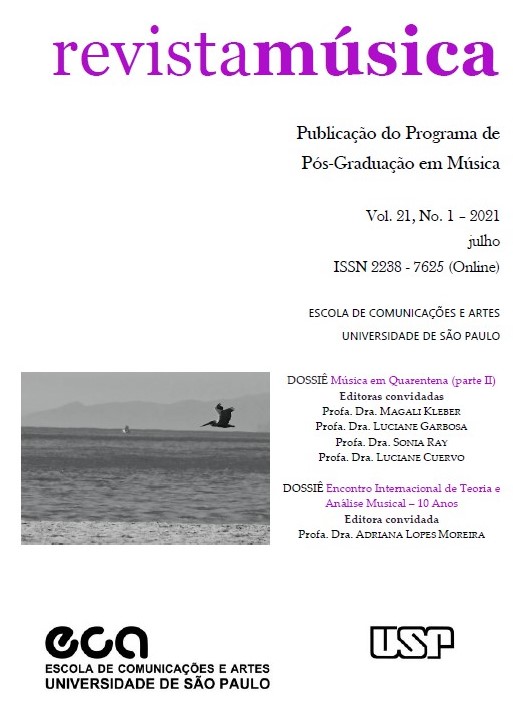Making triadic piano arrangements during pandemics: report of an informal musical interaction using an instant messaging application through a neuroscientific view
DOI:
https://doi.org/10.11606/rm.v21i1.180590Keywords:
Pandemics, Neuroscience, Piano skills, Arranging, KeyboardAbstract
This work is a case study, discussed according to neuroscientific concepts, consisting of a period of musical remote interaction with a female self-learning beginning piano student from Recife, state of Pernambuco (Brazil), using an instant messaging application (Whatsapp), at the time of CODIV-19 pandemics, in which piano arranging activities were proposed. The goal of the study was to investigate changes elicited on the students’ musical practice. Data were collected from application’s chat history and media files. Results point out that the interaction was positive to student’s development. Using Whatsapp as a mean of communication and choosing arranging activities as a pedagogical tool allowed relevant behavior concerning autonomy, motivation and metacognition.
Downloads
References
GLOBAL monitoring of school closures caused by COVID-19. UNESCO (2020). Disponível em: https://en.unesco.org/covid19/educationresponse. Acesso em: 12 dez. 2020.
GUIDANCE Note: Remote Learning & COVID-19. BANCO MUNDIAL (2020). Disponível em: https://documents.worldbank.org/en/publication/documents-reports/documentdetail/531681585957264427/guidance-note-on-remote-learning-and-covid-19. Acesso em: 15 dez. 2020.
DAUBNEY, A.; FAUTLEY, M. Editorial Research: Music education in a time of the pandemic. British Journal of Music Education, 2020. v. 37, n. 2, p. 107–114.
DOMENICO, S. I. DI; RYAN, R. M. The emerging neuroscience of intrinsic motivation: A new frontier in self-determination research. Frontiers in Human Neuroscience, 2017. v. 11, p. 145.
DUCATTI, R. H. A composição na aula de piano em grupo: uma experiência com alunas do curso de Licenciatura em Artes/Musica. Dissertação (Mestrado em Música) – Instituto de Artes, Universidade Estadual de Campinas, Campinas, 2005.
FLEMING, S. M.; DOLAN, R. J. The neural basis of metacognitive ability. Philosophical Transactions of the Royal Society B: Biological Sciences, 2012. v. 367, n. 1594, p. 1338–1349.
GLASER, S.; FONTERRADA, M. Músico-professor: uma questão complexa. Revista Música Hodie, 2007. v. 7, n. 1.
GUY, R.; BYRNE, B. Article Commentary: Neuroscience and Learning: Implications for Teaching Practice. Journal of experimental neuroscience, 2013. v. 7, p. JEN-S10965.
HODGES, D. A. Can neuroscience help us do a better job of teaching music? General Music Today, 2010. v. 23, n. 2, p. 3–12.
HODGES, D. A.; GRUHN, W. Implications of neurosciences and brain research for music teaching and learning. Music and Music Education in People’s Lives: An Oxford Handbook of Music Education, 2018. v. 1, p. 206.
JOU, G. I. DE; SPERB, T. M. A metacognição como estratégia reguladora da aprendizagem. Psicologia: reflexão e crítica, 2006. v. 19, n. 2, p. 177–185.
KANDEL, E. et al. Princípios de neurociências. [S.l.]: AMGH Editora, 2014.
KINNEY, Forrest. Chord Play: the Art of Arranging at the Piano, volumes 1 a 5. Toronto: Frederick Harris, 2010
LAVILLE, C.; DIONNE, J. A construção do saber: manual de metodologia da pesquisa em ciências humanas. Belo Horizonte: UFMG, 1999.
LEMOS, A. et al. Autonomy support enhances performance expectancies, positive affect, and motor learning. Psychology of Sport and Exercise, 2017. v. 31, p. 28–34.
LENT, Roberto. Cem bilhões de neurônios: conceitos fundamentais de neurociência. Rio de Janeiro: Editora Atheneu, 2002.
MENDELSSOHN, Félix. Canções sem palavras: op. 19b. Piano. Leipzig: Breitkopf & Härtel, 1968. 1 partitura. Disponível em: https://imslp.simssa.ca/files/imglnks/usimg/8/8b/IMSLP109641PMLP02671-Mendelssohn_Werke_Breitkopf_Gregg_Serie_11_Band_4_MB_75_Op_19b_scan.pdf. Acesso em: 1 out. 2020.
PIKE, P. D. Improving music teaching and learning through online service: A case study of a synchronous online teaching internship. International Journal of Music Education, 2017. v. 35, n. 1, p. 107–117.
PIKE, P. D.; SHOEMAKER, K. The effect of distance learning on acquisition of piano sight-reading skills. Journal of Music, Technology & Education, 2013. v. 6, n. 2, p. 147–162.
REGELSKI, T. A. Amateuring in music and its rivals. Action, Criticism, and Theory for Music Education, 2007. v. 6, n. 3, p. 22–50.
REIS, L. N. P. P. Dos. Piano em grupo: desenvolvimento das habilidades funcionais através de melodias folclóricas brasileiras. Tese (Doutorado em Música) – Instituto de Artes, Universidade Estadual de Campinas, Campinas, 2017.
ROCHA, J. L. S. Aprendizagem criativa de piano em grupo. [S.l.]: Editora Edgard Blücher, 2016.
SLOAN, D.; NORRGRAN, C. A neuroscience perspective on learning. Chemical Engineering Education, 2016. v. 50, n. 1, p. 29–37.
SWANWICK, K. A basis for music education. [S.l.]: Routledge, 2002.
SWIFT, T.; DESSNER, A. Cardigan. In: FOLKLORE.[S. I.]: Republic, 2020. 1CD, faixa 1.
TAYLOR Swift - cardigan | EASY Piano Tutorial. [S. l.: s. n.], 2020. 1 vídeo (4 min.). Publicado pelo canal PHianonize. Disponível em: https://www.youtube.com/watch?v=KCO0nr92fy8. Acesso em: 03 jan. 2021.
Downloads
Published
Issue
Section
License
Copyright (c) 2021 Marcelo Alves

This work is licensed under a Creative Commons Attribution-NonCommercial-ShareAlike 4.0 International License.
Autores que publicam nesta revista concordam com os seguintes termos:
- Autores mantém os direitos autorais e concedem à revista o direito de primeira publicação, com o trabalho simultaneamente licenciado sob a CC Attribution-NonCommercial-ShareAlike 4.0 que permite o compartilhamento do trabalho com reconhecimento da autoria e publicação inicial nesta revista.
- Autores têm autorização para assumir contratos adicionais separadamente, para distribuição não-exclusiva da versão do trabalho publicada nesta revista (ex.: publicar em repositório institucional ou como capítulo de livro), com reconhecimento de autoria e publicação inicial nesta revista.
- Autores têm permissão e são estimulados a publicar e distribuir seu trabalho online (ex.: em repositórios institucionais ou na sua página pessoal) a qualquer ponto antes ou durante o processo editorial, já que isso pode gerar alterações produtivas, bem como aumentar o impacto e a citação do trabalho publicado (Veja O Efeito do Acesso Livre).


